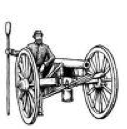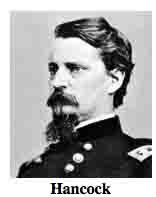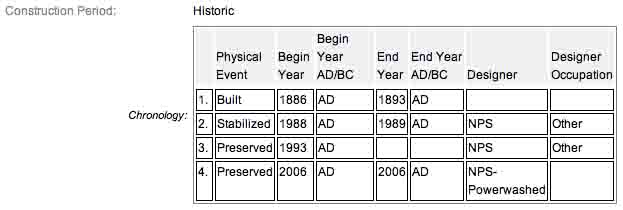
The 2nd United States Corps was also known as Hancock's Corps. The unit was commanded by Winfield Scott Hancock (February 14, 1824 – February 9, 1886) was a career U.S. Army officer and the Democratic nominee for President of the United States in 1880. He served with distinction in the Army for four decades, including service in the Mexican-American War and as a Union general in the American Civil War. Known to his Army colleagues as "Hancock the Superb", he was noted in particular for his personal leadership at the Battle of Gettysburg in 1863. One military historian wrote, "No other Union general at Gettysburg dominated men by the sheer force of their presence more completely than Hancock."
During the massive artillery bombardment of the Union lines on Day 3 of the Battle, Union Major General Hancock road slowly along the lines, greatly inspiring his men as shot and shell rained all around. After conferring with General Stannard, a searing pain shot through Hancock's leg. Although painfully wounded in the upper right thigh with debris, possibly from his saddle, lodging itself eight inches into his flesh, he refused to be borne from the field until he knew that Pickett's Charge was repulsed. Hancock would later say, "I was myself wounded, but was enabled to remain on the field until the action was entirely over, when I transferred the command to Brigadier-General Caldwell." The wound would never completely heal and would effect him for the remainder of his life. SOURCE
The Major General Winfield S. Hancock Wounded Marker is located along  Hancock Avenue (RD310), on the left or west side of the road if traveling traveling north. The monument is 73 feet off of the road in the grass. The road bends at this area. This area is an absolute beehive of activity as this site represents the best of what Gettysburg has to offer, both historically and monumentally.
Hancock Avenue (RD310), on the left or west side of the road if traveling traveling north. The monument is 73 feet off of the road in the grass. The road bends at this area. This area is an absolute beehive of activity as this site represents the best of what Gettysburg has to offer, both historically and monumentally.  Parking is plentiful and is available road-side at intermittently enlarged shoulder cut-outs, usually marked with white striping. Be sure to keep vehicles off the grass or you will be ticketed by park police. I visited this monument on Tuesday, August 7, 2012 at approximately 3:05 P.M. I was at an elevation of 561 feet, ASL. I used a Canon PowerShot 14.1 Megapixel, SX210 IS digital camera for the photos.
Parking is plentiful and is available road-side at intermittently enlarged shoulder cut-outs, usually marked with white striping. Be sure to keep vehicles off the grass or you will be ticketed by park police. I visited this monument on Tuesday, August 7, 2012 at approximately 3:05 P.M. I was at an elevation of 561 feet, ASL. I used a Canon PowerShot 14.1 Megapixel, SX210 IS digital camera for the photos.
The Draw the Sword site helped out by the NPS narrative and the SIRIS site offers the following description: Monument is a tapered granite shaft of coursed rough cut stone except for the center stone and topped with a pyramidal finished stone cap and set on a 2.2 1/2 foot square base. Smooth and rough-hewn blue Westerly granite; base: concrete.It indicates the area where Major General Winfield Scott Hancock was wounded during the closing minutes of Longstreet’s assault on July 3, 1863. Erected between 1886 and 1893. Dedicated 1892. Smith Granite Company, fabricator.
The monument was dedicated May 1, 1888 by friends of hancock. The monument is composed of granite and has the following dimensions: The sculpture is 6 feet 6 inches x 2 feet 2.5 inches x 2 feet 2.5 inches. The monument was fabricated by the Smith Granite Company, who had their hands in countless monuments of that age. There are brief inscriptions on the front and reverse sides which read:
 (Front):Major General
(Front):Major General
Winfield Scott Hancock
wounded
July 3, 1863.
(Back):Erected by
Comrades and Friends
The Major General Winfield S. Hancock Wounded Marker is a contributing feature to the Gettysburg National Military Park Historic District which is nationally significant under NR Criteria A, B, C & D. Areas of Significance: Military, Politics/Government, Landscape Architecture, Conservation, Archeology-Historic. Period of Significance: 1863-1938. The original National Register Nomination was approved by the Keeper March 19, 1975. An update to this nomination was approved by the Keeper on January 23, 2004. The monument is identified as structure number MN251.
From the Nomination Form:
1 of 16 Mn to wounding/death of officers. Indicates location of Maj. Gen. Winfield S. Hancock wounding at close of Longstreet's assault. Although wounded, Hancock remained on the field directing his men. Mn located W side of Hancock Av, near Pleasonton Av.
Short Physical Description:
Mn base 2'2-1/2"sq. Tapered shaft of coursed rough-cut granite except for center stone. Finished w/ excised stone. Pryamidal finished stone cap. Sodded mound restored w/ plastic grid soil retainer, erosion still occurring.
Long Physical Description:
Monument is a tapered granite shaft of coursed rough cut stone except for the center stone and topped with a pyramidal finished stone cap and set on a 2.2 1/2 foot square base. Located on the west side of Hancock Avenue, near Pleasonton Avenue.

My Sources
1.
NRHP Nomination Form
2.
SIRIS
3.
Stone Sentinels
4.
Virtual Gettysburg
5.
Draw the Sword
6.
Historical Marker Database
7.
Wikipedia